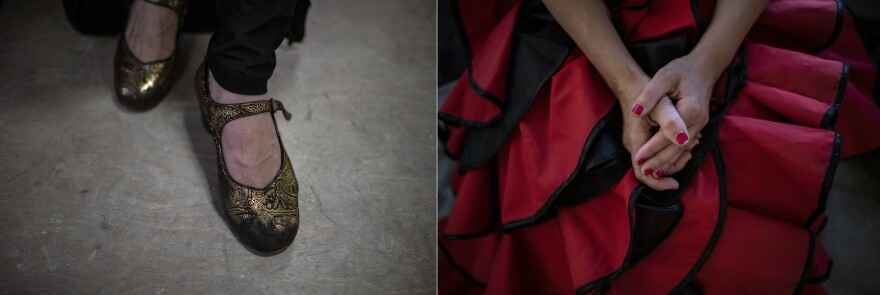Updated July 4, 2022 at 8:15 AM ET
The pandemic placed competitive flamenco dancing on pause in Madrid.
And for the dancers at the legendary Amor de Dios flamenco center, a return to in-person events means a return to the stage.
Some members of NPR's All Things Considered team – Michel Martin, Miguel Macias, Tinbete Ermyas and Kira Wakeam – took a break from covering the NATO summit to get a better understanding of flamenco and its impact on the dancers.
That meant a class with instructor Carmen Rivas, known professionally as Carmen La Talegona, at the center.

Rivas has traveled across Latin America and Europe. For her, Amor de Dios has been her second home since she moved to Madrid from Córdoba at 17.
While the pandemic limited the ability of flamenco artists to perform live, Rivas believes that it made the general public more aware of the dance's power as a storytelling medium.
"People want to express everything they feel and, using movement, percussion and singing as the medium ... it is musical and not just a spectacle."

All Things Considered host Michel Martin learned this lesson firsthand.
"Flamenco incorporates so many artforms from around the world," Martin says. "You see the emotion of opera, and the precision that you find in other classical dance traditions."
"It reminded me of our own step and tap because it's got that fierce percussion rhythm."
Rivas says that isn't a coincidence. Flamenco is transforming with the help of global influences in ways previously considered impossible.
"The older generation gets their inspiration from the great teachers, in Vuitton Manolete, Carmen Amaya, Farruco, Antonio Gades," she said.
"But other dance cultures are inspiring us younger people. Especially African and Black dance traditions, they are enriching flamenco."


For producer and self-described fashion lover Kira Wakeam, the clothes also caught her attention.
"One of the first things for me was these amazing skirts, these traditional skirts that the students are wearing called the bata de cola, which directly translates to a tail robe," she says.
"These are sort of the long, heavy skirts that you've seen on flamenco dancers that flow and move as they dance. And honestly it was really just mesmerizing."



The artform has become a way for senior producer Miguel Macias to reconnect with his native Spain — though he didn't get into flamenco until he immigrated to the U.S.
"Growing up in the south of Spain, flamenco was everywhere, but actually my parents didn't really play flamenco."
At Amor de Dios, he became choked up when the teacher began to sing.
"It just really touched me, the way everything was happening is such a pure artistic way in front of us."

For Rivas, flamenco dancing is less about learning a series of components than it is about abiding by an honor code.
"I always say that every person in the world has a story to tell, and from that story, there is a technique that is made."
In her travels, Rivas has seen how flamenco affects people emotionally.
"People will cry. They have a need to tell their stories and use this medium of movement to relieve their pressures and feel their culture."
Copyright 2023 NPR. To see more, visit https://www.npr.org.








